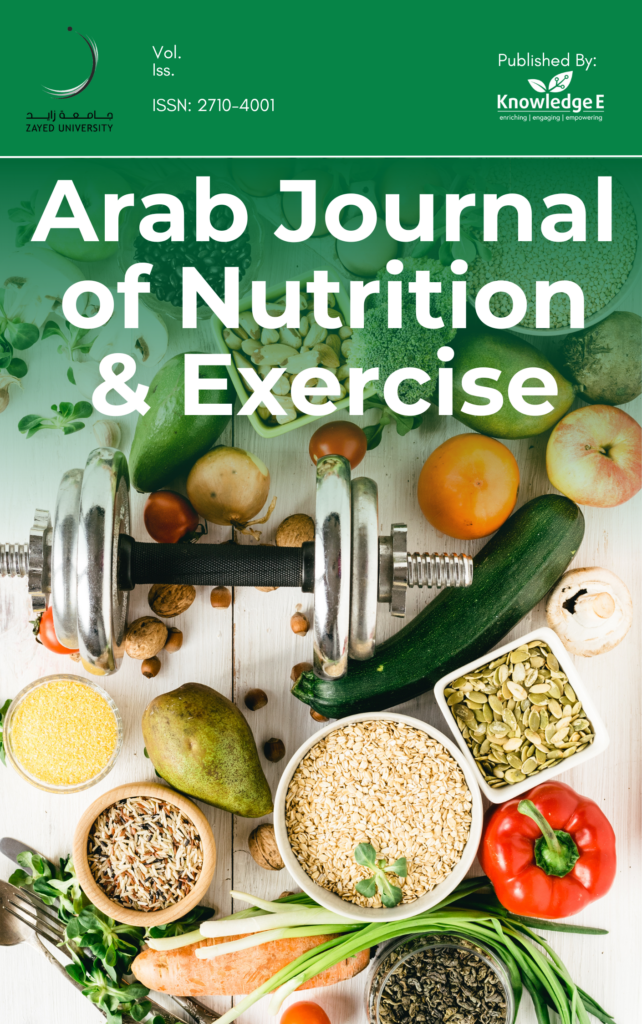
Arab Journal of Nutrition and Exercise
ISSN: 2518-6590
Groundbreaking research on nutrition, physical activity, and public health from across the Arab world.
Omega-3 Fatty Acid Effect in Cardiovascular Disease Risk Factors
Published date:Nov 12 2017
Journal Title: Arab Journal of Nutrition and Exercise
Issue title: AJNE: Vol 1, No 1 (2016)
Pages:15-23
Authors:
Abstract:
Background: One of the leading causes of death around the globe is cardiovascular disease (CVD). Nutrition plays a vital role in the prevention of CVD. However, the effects of margarines, rich in n-3 and n-6 fatty acids, compared to butter, are still controversial in plasma lipid levels.
Method: A single blind parallel study was carried out. Twelve (n=12) healthy UAE University female students were recruited from age 19-24 years old and were randomly allocated in 2 groups. The participants were asked to consume either 25g of margarine or 25g of butter for 1 month and to retain their normal daily dietary habits. Fasting blood samples were collected before the beginning and at the end of the dietary periods for the assessment of lipid profile.
Result: Triglycerides decreased by 12% within the intervention group, total cholesterol, and glucose levels were decreased in both groups, but it was not statistically significant within and between the margarine and butter group.
Conclusion: The present study showed no statistical differences in the effects of butter and margarine, enriched with n-3 and n-6 fatty acid, on cholesterol, triglycerides, and glucose. Further research is necessary with bigger sample size and longer duration.
References:
[1] G. E. Billman, J. X. Kang, and A. Leaf, “Prevention of ischemia-induced cardiac sudden death by n-3 polyunsaturated fatty acids in dogs,” Lipids, vol. 32, no. 11, pp. 1161–1168, 1997.
[2] P. C. Calder, “Immunomodulation by omega-3 fatty acids,” Prostaglandins, Leukotrienes and Essential Fatty Acids, vol. 77, no. 5-6, pp. 327–335, 2007.
[3] R. de Caterina, “n-3 fatty acids in cardiovascular disease,” The New England Journal of Medicine, vol. 364, no. 25, pp. 2439–2450, 2011.
[4] J. Dyerberg, H. O. Bang, E. Stoffersen, S. Moncada, and J. R. Vane, “Eicosapentaenoic acid and prevention of thrombosis and atherosclerosis?” The Lancet, vol. 2, no. 8081, pp. 117–119, 1978.
[5] S. Endres, R. Ghorbani, V. E. Kelley et al., “The effect of dietary supplementation with n-3 polyunsaturated fatty acids on the synthesis of interleukin-1 and tumor necrosis factor by mononuclear cells,” The New England Journal of Medicine, vol. 320, no. 5, pp. 265–271, 1989.
[6] J. M. Geleijnse, E. J. Giltay, D. E. Grobbee, A. R. T. Donders, and F. J. Kok, “Blood pressure response to fish oil supplementation: metaregression analysis of randomized trials,” Journal of Hypertension, vol. 20, no. 8, pp. 1493–1499, 2002.
[7] Global status reports on noncommunicable diseases 2010, Geneva, World Health Organization, 2011.
[8] J. Goodfellow, M. F. Bellamy, M. W. Ramsey, C. J. H. Jones, and M. J. Lewis, “Dietary supplementation with marine omega-3 fatty acids improve systemic large artery endothelial function in subjects with hypercholesterolemia,” Journal of the American College of Cardiology, vol. 35, no. 2, pp. 265–270, 2000.
[9] “Dietary supplementation with n-3 polyunsaturated fatty acids and vitamin E after myocardial infarction: results of the GISSI-Prevenzione trial. Gruppo Italiano per lo Studio della Sopravvivenza nell’Infarto miocardico,” The Lancet, vol. 354, no. 9177, pp. 447–455, 1999.
[10] J. X. Kang and A. Leaf, “Effects of long-chain polyunsaturated fatty acids on the contraction of neonatal rat cardiac myocytes,” Proceedings of the National Acadamy of Sciences of the United States of America, vol. 91, no. 21, pp. 9886–9890, 1994.
[11] P. E. Marik and J. Varon, “Omega-3 dietary supplements and the risk of cardiovascular events: a systematic review,” Clinical Cardiology, vol. 32, no. 7, pp. 365–372,2009.
[12] C. D. Mathers and D. Loncar, “Projections of global mortality and burden of disease from 2002 to 2030,” PLoS Medicine, vol. 3, no. 11, article e442, 2006.
[13] P. L. McLennan, “Myocardial membrane fatty acids and the antiarrhythmic actions of dietary fish oil in animal models,” Lipids, vol. 36, suppl. 1, pp. S111–S114, 2001.
[14] D. Mozaffarian, “Fish, n-3 fatty acids, and cardiovascular haemodynamics,” Journal of Cardiovascular Medicine, vol. 8, suppl. 1, pp. S23–S26, 2007.
[15] R. Sadovsky and P. Kris-Etherton, “Prescription omega-3-acid ethyl esters for the treatment of very high triglycerides,” Postgraduate Medical Journal, vol. 121, no. 4, pp. 145–153, 2009.
[16] C. von Schacky and W. S. Harris, “Cardiovascular benefits of omega-3 fatty acids,” Cardiovascular Research, vol. 73, no. 2, pp. 310–315, 2007.
[17] A. C. Skulas-Ray, S. G. West, M. H. Davidson, and P. M. Kris-Etherton, “Omega-3 fatty acid concentrates in the treatment of moderate hypertriglyceridemia,” Expert Opinion on Pharmacotherapy, vol. 9, no. 7, pp. 1237–1248, 2008.
[18] The global burden of disease: 2004 update, Geneva, World Health Organization, 2008.
[19] F. Thies, J. M. C. Garry, P. Yaqoob et al., “Association of n-3 polyunsaturated fatty acids with stability of atherosclerotic plaques: a randomised controlled trial,” The Lancet, vol. 361, no. 9356, pp. 477–485, 2003.
[20] C. von Schacky, “A review of omega-3 ethyl esters for cardiovascular prevention and treatment of increased blood triglyceride levels,” Vascular Health and Risk Management, vol. 2, no. 3, pp. 251–262, 2006.